 |
The Fortifications of Cork
Cork, Ireland, UK
|
|
 |
|
The monastic settlement of Cork was founded (probably) in the sixth century AD, and the Treaty of Windsor (1175) established English King Henry II (1133-1189) as Ireland's ruling monarch. Cork was completely walled sometime in the Middle Ages, which kept its urbane, sophisticated inhabitants safe from Ireland's weirdly-speaking Gaelic locals.
Cork Harbour is one of several "second-largest natural harbors in the world," the undisputed first being Port Jackson in Sydney, Australia. The British Empire became what it was thanks in no small part to its navy, so it's no surprise that the Royal Navy had a warm place in its collective heart for Cork Harbour.
From about 1550 until 1938, England busily populated the city of Cork and its waterborne approaches with fortifications. In the interest of making everything as historically confusing as possible, all of Cork Harbour's major fortifications were renamed following Irish independence.
|
 |
|
|
Click on any of the fortifications listed below to be taken straight to its description!
|

|
|
|
The ever ebbing-and-flowing threat from France caused the fortification, by this point known as Ram's Head Battery, to be upgraded to actual, official fort status at the end of the 18th century. The Royal Navy base at Kinsale, which had historically proven to be somewhat vulnerable to guys in ships, was moved to Haulbowline Island in Cork Harbour. Fort Westmoreland was being built on nearby Spike Island, and the fortifications on either side of the entrance to Cork Harbour were felt to be in need of improvement. The fort of our current, if brief, interest was named Fort Camden at this time, after John Pratt, the 1st Marquess of Camden (1759-1840): Pratt was the present Lord Lieutenant of Ireland.
|
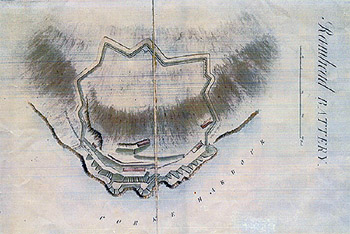 Ram's Head Battery, circa 1779 Ram's Head Battery, circa 1779 |
 |
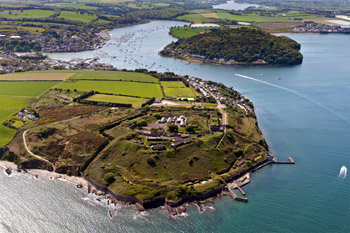 Camden Fort Meagher today, from the southeast Camden Fort Meagher today, from the southeast |
|
By the 1830's nobody cared much about defending Cork Harbour, and Fort Camden was used as a prison. The Royal Commission on the Defence of the United Kingdom formed in 1859, however, and swiftly determined that Britain would be unable to defend itself should a well-equipped foreign power come a-callin'...the resurgent French Empire was of course the prime concern. This undertaking was headed by Prime Minister Lord Palmerston (1784-1865), whose determination to fortify Great Britain for the modern age left us with a great many extremely interesting examples of the art of mid-19th-century fortification: Several "Palmerston Forts" were duly constructed around the ports of southern England in this period.
|
Fort Camden's massive overhaul began in 1861, with well over half of its new structures being built underground, so as to better withstand the sort of accurate, exploding ordnance of which they expected to be at the receiving end. The new Fort Camden covered 45 acres, and was built with convict, military and civilian labor.
Weaponry was upgraded in the 1880's and 90's, and larger, breechloading guns were mounted. A launching facility for the Brennan Torpedo, one of the world's first successful guided munitions, was built at Fort Camden at this time.
|
 |
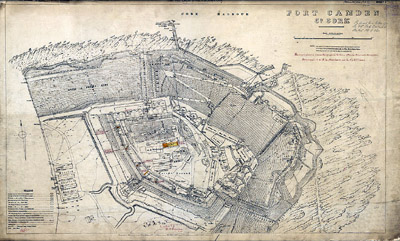 The hulking Fort Camden, as it marched resolutely into the 20th century The hulking Fort Camden, as it marched resolutely into the 20th century |
|
At the height of its mystical powers, Fort Camden was garrisoned by seven officers, over 200 men, and mounted around 20 guns. The Anglo-Irish Treaty that ended the Irish War of Independence stipulated that Ireland's harbo(u)r defens(c)es remain in the hands of the British Army, but Fort Camden was finally handed over to the Irish military in 1938. The fort was manned during the First and Second World Wars, but no German U-Boats came out to play.
Sometime after the Second World War, Fort Camden was renamed Fort Meagher, after Thomas Francis Meagher (1823-1867), who had been a leader of the Young Irelanders, a nationalist group that staged a rebellion in 1848. This rebellion was less than successful, and Meagher was transported to Australia...but this enterprising fellow escaped in 1852 and made his way to the United States. Meagher enlisted in the US Army at the start of the American Civil War (1861-1865), and rose to the rank of Brigadier General. After the war he was appointed Secretary of State for the Territory of Montana, and drowned in the Missouri River in 1867. I'm not generally in favor of renaming starforts, but for this guy I'll make an exception!
|
|
|
|
|
|
When Fort Westmoreland was built on nearby Spike Island in the early 19th century, followed by the enhancements of Fort Camden and Fort Carlisle at the mouth of Cork Harbour, Cove Fort was no longer necessary as a defensive entity.
|
|
|
Today, Cove Fort is home to a harbor pilot station and a Port of Cork operations building.
|

|
|
|
Whatever arrangement of fortifications and guns that had been collected there was known as King John's Fort by the time of the Williamite War (1688-1691)...just in time for William's forces, on their way to bombard Cork, to creep up from behind and capture the fort in 1690.
The 1790's saw some improvement to what may or may not still have been known as King John's Fort, and French prisoners of war were stored in the fort and its tunnel complex during the Napoleonic Wars (1803-1815).
|
 Fort Carlisle from across the entrance to Cork Harbour, from Fort Camden...sometime in the late 19th century. Fort Carlisle from across the entrance to Cork Harbour, from Fort Camden...sometime in the late 19th century. |
 |
Fort Carlisle finally became Fort Carlisle in the mid-19th century, named for Frederick Howard, 5th Earl of Carlisle (1748-1825). Howard had been England's First Lord of Trade until 1780, when he was made Lord Lieutenant of Ireland, which office he held for about a year and a half.
The Fifth Earl of Carlisle oversaw Ireland during what could have been a difficult period, with the bothersome ideas of the American Revolution infecting the populace and most British troops having been removed from Ireland to fight elsewhere...but the Carlisle period passed in peace, which was apparently enough of an accomplishment to name a starfort after him. Or, maybe they were looking for alliteration amongst their forts: Carlisle, Camden, Cove and...Westmoreland.
|
|
The addition of tons of concrete modernized Fort Carlisle in the 1860's, when all of Cork's defenses, and indeed many of Southern England's defenses, were getting a much-needed upgrade, thanks to the portentious rumblings of Napoleon III (1808-1873).
The First World War saw Fort Carlisle manned by the Royal Garrison Artillery Coastal Defence, and our fort was untouched by Ireland's War of Independence...although there are a number of graves within the fort that date to this period. Surely no one died of natural causes during the Irish War of Independence?
|
|
|
More coastal artillery units manned the fort during "The Emergency," as Ireland refers to the Second World War. Today Fort Davis is owned by the Ireland's Department of Defence, and is used by the Irish Army a training site: As such it is not open to the public.
|

|
|
 |
The port at Kinsale, about a dozen miles southwest from the entrance to Cork Harbour, was fortified by the English James Fort and Charles Fort) after a dastardly Spanish plan, in which Spanish forces would unite with the Irish, scour the English from Ireland and then use that island as a staging ground for an attack on England was foiled in 1601. Sir George Carew (1555-1629), representative of Queen Elizabeth I (1533-1603), was in charge of Cork and its environs, and ordered the construction of a fort in her name (which was Elizabeth) on the southern border of the city in 1601. This fort was intended not to keep the city safe from outside threats, but to monitor and control its notionally rebellion-minded inhabitants. |
|
Elizabeth Fort remained a bastion of Corkian Englishness until the 1920's, and it has its own dedicated page on this very site! You may click on the words Elizabeth Fort to visit that page, or if that's too complicated, you could click on the fort's image above, or you could even click here if you wish. Or here, or here, but definitely not here.
|
|
|
|
Fort Westmoreland is detailed on its own page at Starforts.com, which you may visit should you wish for this beautiful starfort's whole story.
|

|
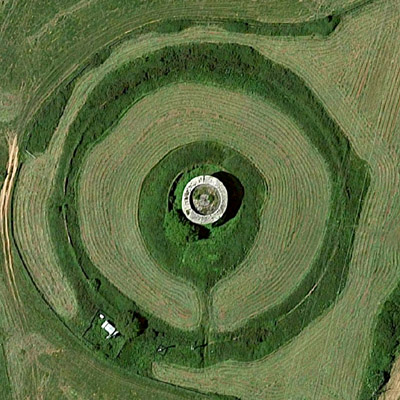 Ringaskiddy Martello Tower. Is there a better word than Ringaskiddy? I submit that there is not. Ringaskiddy Martello Tower. Is there a better word than Ringaskiddy? I submit that there is not. |
 |
Five Martello Towers were built for the defense of Cork at the beginning of the 19th century: These were Fota, Belvelly, Rossaleague, Haulbowline and Ringaskiddy. The Martello Tower was a stout, multistory cylinder with a heavy gun at its top, which could be traversed through 360°. This relatively cheap alternative to building a more substantial fortification was popular with the British military through the 19th century, and their squat forms dotted the British Empire. Cork's Martello Towers were armed and lightly manned until the 1860's. On December 26, 1867, five men burst into Fota Tower, surprising the two artillerymen and their families who were living therein. |
|
The infiltrators made off with powder, shot and a couple of carbines, but left the gunners and their families unharmed. This event changed Cork's Martello Tower policy for good.
|
Recognized as the underguarded depositories of munitions in which Irish revolutionaries had a keen interest that they were, all five of these towers were disarmed and more or less abandoned in 1868.
Belvelly was used by the military as an observation tower during the First World War (1914-1918), but the towers' military import pretty much died in 1868. All have been repurposed in various ways since then: Haulbowline, on an island that has become an Irish Navy post, sported a fashionable iron water tank atop from 1868 until the 1990's, providing what must have been fresh and delicious water to Royal and Irish Naval vessels.
|
 |
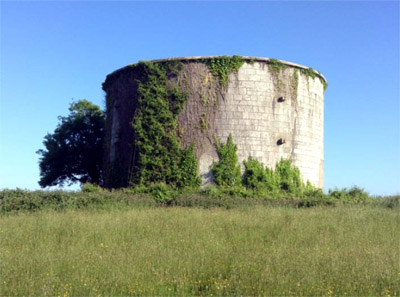 Ringaskiddy Martello Tower, from the Facebook page of the catchily-named Ringaskiddy Rights of Way Commission. Ringaskiddy Martello Tower, from the Facebook page of the catchily-named Ringaskiddy Rights of Way Commission. |
|
Once the rusty water tank had been removed, a period gun was reaffixed in its place, and today Haulbowline Martello Tower is a museum. Belvelly has been developed into a luxury home; Ringaskiddy, the biggest tower of them all, has gone through numerous rehabilitation attempts, but today sits and rots in a fetching manner.
|

|
At the dawn of the 20th century, the grand masonry fortification had been old news for 40 years, the starfort for nearly a hundred.
|
 |
|
|
Small batteries of enormous, rifled guns could cover dozens of miles in all directions, effectively closing off the kind of harbor entrances that several forts had been needed to defend a century earler...and littoral defendin' was foremost in the military mind of this period, as everybody who was anybody was frantically building dreadfully dynamic dreadnaughts.
Cork Harbour's main defensive entities, Fort Camden and Fort Carlisle, were considered insufficient to the task of protecting the harbor into the Lovecraftian 20th century. Monsterous BL (Breech Loading) 9.2 Inch Mark X guns were thought to be just the thing to prevent the errant German, Frenchman or whomsoever from entering Cork Harbour, but mounting them in the existing fortifications would have been problematic, involving the construction of entire new batteries within the forts to support them. Thus Templebreedy Battery was born.
|
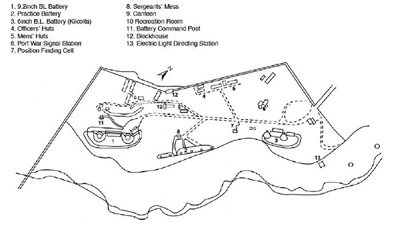 Wondering which hut was placed where at Templebreedy Battery? Wonder no more. Wondering which hut was placed where at Templebreedy Battery? Wonder no more. |
 |
Named not for a person but its location, Templebreedy Battery was built from 1904 to 1909. Underground magazines, searchlights and machine gun positions made this a most modern defensive position. Housing for nine officers and 81 men were on site. A battery for two BL 6-Inch Mark VII guns was also built, but the guns were never mounted.
The battery was hanging out on a bit of a limb during the Irish War of Independence, its isolation leading to a number of attacks on its supply deliveries. As the IRA possessed no navy, it's easy to imagine that the men of Templebreedy Battery wondered what they were doing in such an exposed place.
|
|
Ireland found it unnecessary to rename Templebreedy Battery following independence, as it hadn't been named after a haughty Englishman in the first place. The battery was handed over to the country in which it sat in 1938, and Irish Defence Forces manned it, uneventfully, through the Second World War, after which conflict it was "largely" decommissioned. The big guns remained in place until the 1960's, and the Irish military consinued to utilize the site for training purposes into the 1980's.
Today, Templebreedy Battery looks to be an interesting warren of unarmed batteries and support structures. A "pitch and putt" golf course was established on the battery's grounds in the 1990's, which reportedly closed in 2005. Invented in the 1940's, "pitch and putt" appears to be golf, though on a much smaller scale, doing away with that annoying long-distance drive. Is it what we in the United States know as Miniature Golf? Of course not, pitch and putt is a real sport, for real sportsmen who for whatever reason can't handle real golf.
|
|
|
|
|
|
 |




